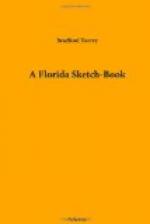As I have said, I followed the road over the nearly level plateau for what I guessed to be about three miles. Then I found myself in a bit of hollow that seemed made for a stopping-place, with a plantation road running off to the right, and a hillside cornfield of many acres on the left. In the field were a few tall dead trees. At the tip of one sat a sparrow-hawk, and to the trunk of another clung a red-bellied woodpecker, who, with characteristic foolishness, sat beside his hole calling persistently, and then, as if determined to publish what other birds so carefully conceal, went inside, thrust out his head, and resumed his clatter. Here, too, were a pair of bluebirds, noticeable for their rarity, and for the wonderful color—a shade deeper than is ever seen at the North, I think—of the male’s blue coat. In a small thicket in the hollow beside the road were noisy white-eyed vireos, a ruby-crowned kinglet,—a tiny thing that within a month would be singing in Canada, or beyond,—an unseen wood pewee, and (also unseen) a hermit thrush, one of perhaps twenty solitary individuals that I found scattered about the woods in the course of my journeyings. Not one of them sang a note. Probably they did not know that there was a Yankee in Florida who—in some moods, at least—would have given more for a dozen bars of hermit thrush music than for a day and a night of the mocking-bird’s medley. Not that I mean to disparage the great Southern performer; as a vocalist he is so far beyond the hermit thrush as to render a comparison absurd; but what I love is a singer, a voice to reach the soul. An old Tallahassee negro, near the “white Norman school,”—so he called it,—hit off the mocking-bird pretty well. I had called his attention to one singing in an adjacent dooryard.




